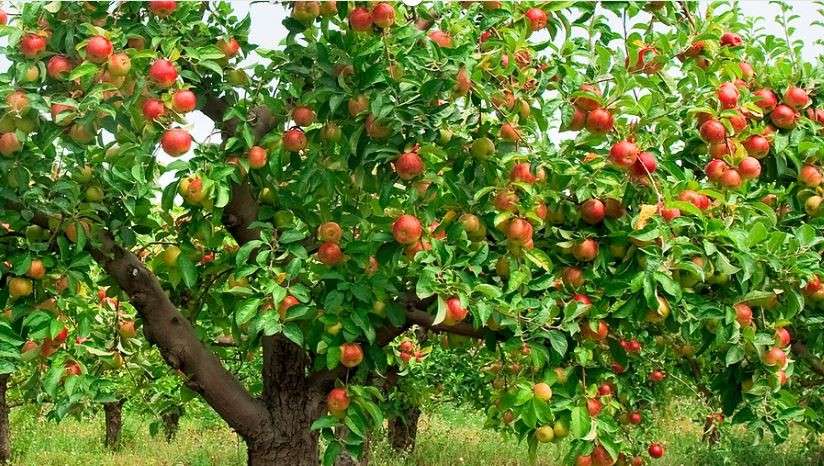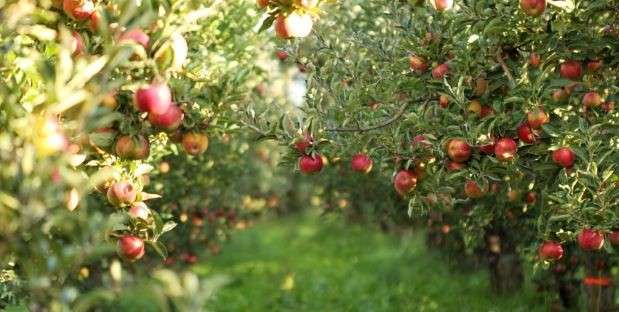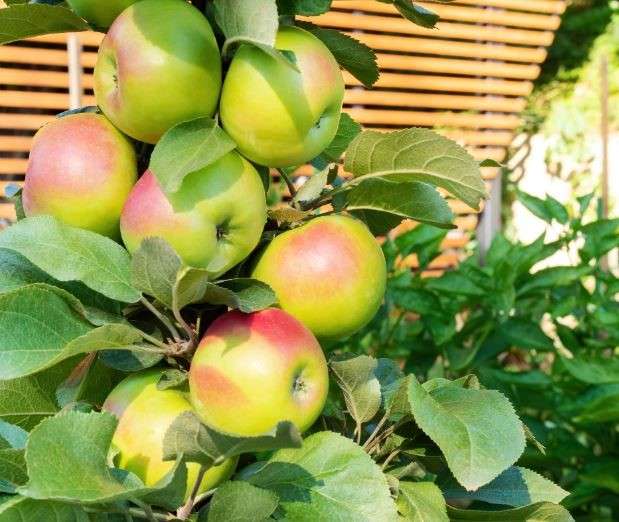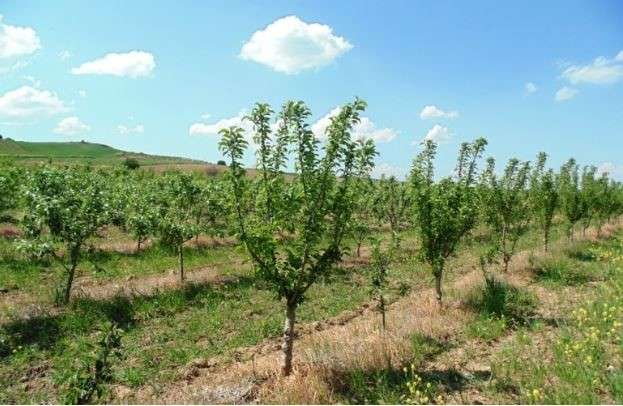
The Benefits of Self-Fertile Apple Trees
Self-fertile apple trees are a great option for home gardeners who want to enjoy a bountiful harvest of delicious apples without the need for multiple trees for cross-pollination. In this post, we’ll explore the benefits of self-fertile apple trees and provide tips on how to care for and maintain them to ensure a successful and fruitful harvest. Whether you’re a seasoned gardener or just starting out, self-fertile apple trees can be a great addition to your garden.
Table of Contents
ToggleUnderstanding Self-Fertile Apple Trees

A. Definition and characteristics
Self-fruitful apple plants are able to pollinate themselves and produce fruit without the need for another tree for cross-pollination. This means that you can have just one tree in your garden and still enjoy a successful harvest of delicious apples. These trees are a great option for home gardeners who may not have space for multiple apple trees or who want to simplify their fruit tree care. Self-pollinating apple trees also tend to be more compact in size, making them a great option for smaller gardens or yards. Additionally, they are often easier to care for and maintain, making them a great option for beginner gardeners. Overall, Self-fruitful apple plants offer convenience and productivity for home gardeners looking to grow their own fruit.
B. Mechanisms of self-pollination
Self-fruitful apple plants have the ability to pollinate themselves, meaning they do not require another tree for cross-pollination. This is advantageous for home gardeners as it allows for successful fruit production with just one tree. The compact size of these trees makes them ideal for smaller gardens or yards, and they are generally easier to care for and maintain. This makes them a great option for beginner gardeners or those looking to simplify their fruit tree care. Overall, self-pollinating apple trees offer convenience and productivity for home gardeners looking to grow their own fruit.
Enhanced Yield and Efficiency

A. Elimination of the need for cross-pollination
One of the main benefits of Self-fruitful apple plants is that they do not require another tree for cross-pollination. This means that you can have a successful fruit production with just one tree, making it a convenient option for home gardeners. This also eliminates the need to worry about having multiple trees for cross-pollination, making it easier to care for and maintain these trees. With the compact size of self-pollinating apple trees, they are also ideal for smaller gardens or yards, making them a great option for beginner gardeners or those looking to simplify their fruit tree care. Overall, Self-fruitful apple plants offer convenience and productivity for home gardeners looking to grow their own fruit.
B. Increased fruit set and yield
Are also benefits of independent fertilization apple trees. Since they do not rely on cross-pollination, these trees can produce more fruit and have a higher yield compared to trees that require cross-pollination. This can result in a bountiful harvest of delicious apples for you to enjoy. Additionally, the convenience of not needing to worry about cross-pollination allows for a more efficient and productive fruit tree care routine. With proper care and maintenance, self-fertile apple trees can thrive and provide an abundance of fruit for your enjoyment. Whether you are a beginner gardener or an experienced horticulturist, self-pollinating apple trees can be a great addition to your home garden.
Climate and Location Adaptability

A. Tolerance to variable environmental conditions
Tolerance to variable environmental conditions is another benefit of self-fertile apple varieties. These trees are more adaptable to different climates and locations, making them a great choice for home gardeners. They are more resilient to changes in weather and environmental factors, allowing them to thrive in a wider range of conditions. This means that even if you live in an area with unpredictable weather patterns, you can still successfully grow independent fertilization apple trees and enjoy a bountiful harvest. Additionally, their ability to tolerate variable environmental conditions makes them a low-maintenance option for home gardeners, as they require less attention and care compared to other fruit trees. With the right care and maintenance, independent fertilization apple trees can continue to produce delicious apples year after year, regardless of the climate and location they are grown in.
B. Expansion of apple cultivation to non-traditional regions
self-fertile apple varieties have the advantage of being able to adapt to different climates and locations. This makes them a great option for home gardeners who may live in areas with unpredictable weather patterns. These trees are resilient and require less maintenance compared to other fruit trees. With the right care, they can continue to produce delicious apples year after year, even in non-traditional regions. This opens up new opportunities for apple cultivation beyond the traditional apple-growing areas.
Increased Convenience for Growers
A. Simplified orchard management practices
Are a major advantage of Solo-pollinating apple trees. These trees do not require cross-pollination from other apple tree varieties, making it easier for home gardeners to manage their orchards. This eliminates the need to plant multiple apple tree varieties to ensure pollination, saving both time and space in the garden. With self-fertile apple varieties, growers can focus on the care and maintenance of a single tree, making orchard management more convenient and less labor-intensive. Additionally, these trees are often more compact in size, making them suitable for smaller garden spaces. This increased convenience makes self-fertile apple trees an attractive option for home gardeners who want to enjoy the benefits of homegrown apples without the added complexity of managing multiple tree varieties.
B. Lower risk of pollination failure and fruit loss
Lower risk of pollination failure and fruit loss is another significant benefit of self-fertile apple varieties. Since these trees can pollinate themselves, there is a lower risk of pollination failure, which can lead to a higher fruit yield. This means that home gardeners are more likely to have a successful harvest of apples without the worry of inadequate pollination. With Solo-pollinating apple trees, there is also a reduced risk of fruit loss due to pollination issues, resulting in a more reliable and bountiful harvest. This can be especially beneficial for gardeners who may not have access to other apple tree varieties for cross-pollination, ensuring that they can still enjoy a plentiful harvest of delicious, homegrown apples. Proper care and maintenance of self-fertile apple trees, such as regular watering, fertilizing, and pruning, can help to maximize their fruit production and overall health. By providing the necessary care, home gardeners can enjoy the rewards of growing their own apples with ease and confidence.
Sustainability and Environmental Benefits

A. Reduction in pesticide usage
Self-productive apple trees can lead to a reduction in pesticide usage. With the ability to pollinate themselves, there is less reliance on external pollinators such as bees, reducing the need for pesticides to protect these pollinators. Additionally, a successful and abundant harvest from self-fertile apple trees can also reduce the need for pesticides to manage pests and diseases, as healthy trees are better able to resist these issues on their own. This can be advantageous for home gardeners who are looking to minimize their environmental impact and promote sustainable gardening practices. By choosing self-fertile apple trees, gardeners can contribute to a healthier and more sustainable ecosystem in their own backyard.
B. Preservation of pollinator populations
Preservation of pollinator populations is another important benefit of self-fertile apple trees. With the decline of bee populations in recent years, it’s crucial to find ways to support and preserve these essential pollinators. By reducing the reliance on external pollinators, Self-productive apple trees can help to maintain and protect bee populations. This is especially important for home gardeners who want to contribute to the preservation of pollinators in their local environment. By choosing self-fertile apple trees, gardeners can play a role in promoting healthy pollinator populations and ensuring the continued pollination of their fruit trees. This can have a positive impact on the overall health of the ecosystem and support the sustainability of gardening practices. By reducing the need for external pollinators and pesticides, self-fertile apple trees offer a more environmentally-friendly approach to fruit tree cultivation.
Economic Advantages
A. Cost savings associated with reduced inputs and labor
Another advantage of Self-productive apple trees. With these trees, you don’t need to purchase and plant multiple trees to ensure cross-pollination. This can save money on purchasing and planting additional trees. Additionally, the reduced reliance on external pollinators means that there is less need for labor-intensive tasks such as hand pollination. This can save time and effort for home gardeners. Overall, self-fertile apple trees offer economic benefits by reducing the need for additional inputs and labor, making them a cost-effective choice for home gardeners. When caring for self-fertile apple trees, it’s important to provide proper maintenance and care to ensure a bountiful harvest. Regular pruning, watering, and fertilizing are essential for the health and productivity of these trees. By following these tips, home gardeners can enjoy the benefits of self-fertile apple trees and contribute to the preservation of pollinators and the environment.
B. Long-term profitability and return on investment
Are important factors to consider when planting Self-productive apple trees. These trees can provide a steady supply of fruit without the need for additional pollinators, making them a cost-effective choice for home gardeners. By reducing the reliance on external pollinators, home gardeners can save money on purchasing and planting additional trees. Additionally, the reduced need for labor-intensive tasks such as hand pollination can save time and effort. This can ultimately contribute to long-term profitability and return on investment for home gardeners. To ensure the continued success of self-fertile apple trees, it’s important to provide proper maintenance and care. Regular pruning, watering, and fertilizing are essential for the health and productivity of these trees. By following these tips, home gardeners can enjoy the economic benefits of self-fertile apple trees while contributing to the preservation of pollinators and the environment.
Challenges and Considerations
A. Genetic diversity and susceptibility to diseases
Are important factors to consider when choosing self-fruitful apple varieties for your home garden. These trees are advantageous for home gardeners because they do not require external pollinators to produce fruit, saving money and time. However, it’s important to be aware that self-fertile trees may have less genetic diversity, making them more susceptible to diseases. To maintain the health and productivity of self-fertile apple trees, proper care and maintenance are essential. This includes regular pruning, watering, and fertilizing to ensure the longevity and profitability of these trees. By understanding the benefits and challenges of self-fruitful apple varieties, home gardeners can make informed decisions about incorporating them into their garden and enjoy the rewards of bountiful fruit production.
In conclusion, self-fruitful apple varieties offer the convenience of not needing a second tree for pollination, making them ideal for smaller gardens or urban spaces. They also tend to produce higher yields and are more reliable in terms of fruit production. With proper care and maintenance, these trees can provide a consistent supply of delicious apples for you and your family to enjoy. If you’re considering adding fruit trees to your garden, self-fertile apple trees are definitely worth considering.
Frequently Asked Question
Self-fertile apple trees are trees that can produce fruit without needing to be cross-pollinated with another apple tree. This means you can have a single tree in your garden and still get a good crop of apples
The main benefit is that you only need one tree to produce fruit, so you don’t need to worry about planting multiple trees for cross-pollination. This can save space in your garden and make it easier to manage your fruit trees.
Yes, self-fertile apple trees can produce just as much fruit as traditional apple trees. As long as they are well cared for and have the right growing conditions, they can yield a bountiful harvest.
One potential disadvantage is that some self-fertile apple trees may still benefit from cross-pollination, which can result in a larger and more consistent crop. However, this is not always necessary for all self-fertile varieties.
Yes, self-fertile apple trees can be grown in containers, making them a great option for small gardens, patios, or balconies. Just make sure the container is large enough to accommodate the tree’s root system and provide proper drainage.
Some popular self-fertile apple tree varieties include ‘Braeburn’, ‘Gala’, ‘Golden Delicious’, and ‘Jonagold’. These varieties are known for their delicious fruit and are well-suited for home gardeners.
Like all fruit trees, self-fertile apple trees require regular pruning, watering, and fertilizing to ensure healthy growth and fruit production. It’s also important to protect the trees from pests and diseases.
Yes, there are self-fertile apple tree varieties that are suitable for a wide range of climate zones, so you can find a variety that will thrive in your specific location. Be sure to research which varieties are best suited for your climate before planting.
